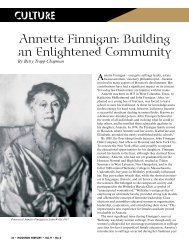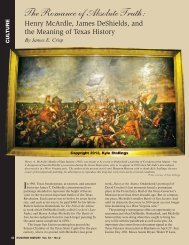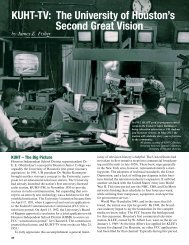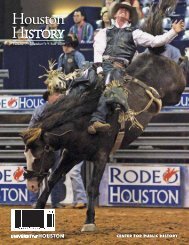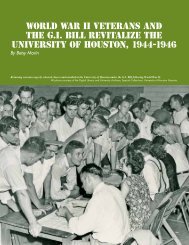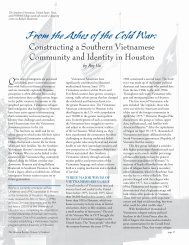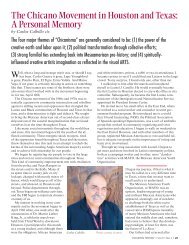You also want an ePaper? Increase the reach of your titles
YUMPU automatically turns print PDFs into web optimized ePapers that Google loves.
young player, you know, to try to maybe challengehim to perform at a higher level than hemight be ready for, just to see what will happen.There are two schools of thought on that. Somepeople feel like the young prospect should moveup one step at a time and that you should not putthem into an overwhelming situation becausethey might lose their confidence. My feeling hasbeen that if you put them into that kind of a situationand they fail, they will probably learn whythey failed and then they will go back down. Ifthey are the kind of competitor that you want,they will go back down there and work on thatand fix it and come back up again. And if theyare somebody that once defeated, they are goingto be defeated forever, they are probably not theperson you want anyway.The trend has been to take longer and longer[to bring pitchers to the majors]. What happenedwith me is not going to happen again. [I was] astarting pitcher’s manager—if you are a startingpitcher that likes to get the decision. What I would tell them iswhen you go out there to start the game, you want the decision— win or loss. If you are afraid to lose, you know, you are goingto always be one to bail out of a tied game in the fifth or sixthinning; that way, you cannot lose. The proper mental attitude isto go for the win even at the expense of a possible loss and pitchas far into the game as you can so you do not need as much helpfrom the bullpen. And mostly guys responded well to that. Wewere on a four-man rotation and pitching lots of complete games[when I was coaching the Astros]. We used to pitch the wholeseason on the fourth day.I did not know that much about pitching when I signed [as arookie]. I signed because I could throw the ball hard, and I couldthrow it over the plate. And I had a pretty good breaking ball.But I did not really have the best idea of what to do with that.The process of learning how to pitch was expedited by pitchingin more games and more innings and being coached by professionals….Once I signed, the process really moved forwardquickly, especially, you know, having to try to compete in themajor leagues. I could not only see what was happening to mewhen I was on the mound and talked to the catcher about it andthe pitching coach or the manager. But I could also watch whatJuan Marichal was doing, or what Warren Spahn was doing, andDon Drysdale, or Bob Gibson. I mean, you are right there whereyou can watch and see the best pitchers doing it, you know, andthat really helped me learn what to do, too. So, it was a combinationof pitching more innings and watching better pitchersand getting better coaching.Jim Owens was a team mate. He pitched the first year ortwo that I played. He was on the staff, then he became pitchingcoach. And I probably learned most of the early lessons fromhim. And after him, the guy that was really good was RogerCraig. He came through as pitching coach for two or three yearshere during the middle of my career…. It is sort of an interestingdynamic because when young guys come up, they obviouslytake another guy’s place. And so, a lot of times, the guy’s placeyou take might be a popular guy among the other pitchers andthey might be a little disgruntled at first but everybody knowsAs a young player who had justjoined the majors, Larry Dierkerenjoyed the first class treatment,which he said would be “minorleague” by today’s standards.that that is the nature of the sport. So, after theguy is gone and you are there for a while, thenyou are on the team trying to help and they starttrying to help you.One of the things that really helped me wasthere was not much pressure because we knewwe were not a contending team….It was nopressure, you are in the major leagues, gettingfirst class treatment, riding around in charteredplanes, having people give you money for yourmeals and stuff. It was glamorous to me. Bytoday’s standards, it would be minor league, butfor me at that time and that age, I was thrilled.Every I time I went back to college, I startedafter the baseball season, so I was usually twoweeks to a month late coming into classes. Icould catch up just fine in classes like English orhistory or anything where you read a book andthen you have to write about what you read, butwhen it came to things that were more technical,I was in trouble. About my third or fourth year,I thought I should major in business because I had some money,and I thought that would be a prudent thing to do. But when Icame back to calculus and accounting and computer science onemonth late, I was lost. Within a couple of weeks, I dropped allthose classes, and I ended up with political science and economics.And the next year, I switched over to majoring in English.One thing that helped me a lot — we got Johnny Edwardsover from the Cardinals and he was a good catcher. In 1969 (atthe age of twenty-two) in spring training, I actually went 5-0,and he was just adamant that if I was going to pitch in the majorleagues, I needed to learn how tothrow pitches other than my fast ballbehind [in] the count 3-2. I workedon that a lot in spring training, andI found that I could get the ball overthe plate, or if I did not, they wouldswing at it if it was out of the strikezone because they were all lookingfor fast balls. And that was oneof the last pieces in the puzzle—you know, of putting together allthe things I had to offer on themound—to have enough confidenceto do those sorts of things. And hewas instrumental in that.I feel like you could imagine howI would feel, or how any twentytwo-year-oldwould feel, in thatposition. I think I was pretty fullof myself, you know. It was a goodfeeling. I knew I was one of the bestand I knew it was not an accident.I was happy about it, and I wasa big shot. I knew I was going tomake a bunch more money. I thinkeverybody has to work that out forthemselves because one thing thatI felt several times is when I was in6 Vol. 6, No. 3–Sports




